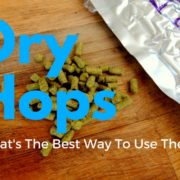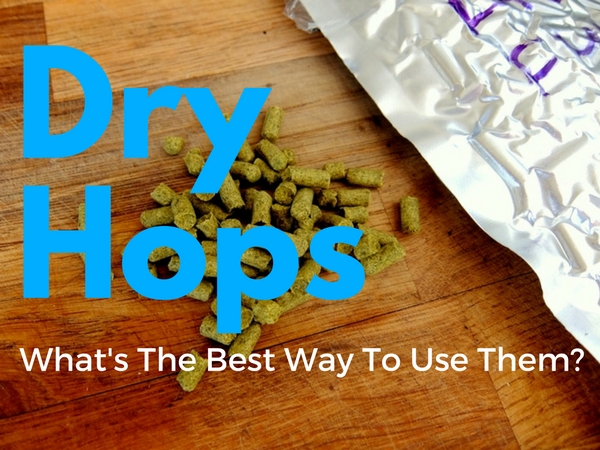What’s The Best Way To Dry Hop A Beer?
Like in all aspects of homebrewing there are many ways to reach the same end result. Dry hopping a beer is certainly no different. Just take a look online and you’ll find numerous ways, techniques and lengths of time in which to dry hop a beer. The good news is that any of the techniques you may have read or researched already, will definitely work and you’ll end up with a great dry hopped beer.
What is the best way to dry hop a beer, though? I would say it is the technique which is simplest and quickest to do for you the brewer. The technique that I find the simplest is what I’m going to share with you now.
Table of Contents
What Do We Want To Achieve With Dry Hopping?
The whole purpose of dry hopping is to introduce the aroma of our chosen hop varieties without any of the bitterness. Adding the hops to the fermenter when the beer is cool rather than in the kettle helps to retain some of the delicate and subtle aromas of the hops, that would otherwise be driven off by the heat of the boiling wort.
When you open a bag of hops rub together the flowers or pellets and take a deep sniff, the aroma that comes off is to a certain extent what we’re trying to capture in the beer. In practice, the effect of dry hopping captures more than just the aroma that you are smelling in the hops. When you taste a dry hopped beer you are experiencing the aroma in more ways than just smelling the flowers, this leads to all sorts of aroma characteristics to appear in the beer that you maybe can’t detect just by smelling alone. The interplay of hops and yeast also creates interesting aromas in itself.
Knowing that we want to capture the aroma of hops by adding them to the fermenter, it’s now a case of deciding how to go about that. When should we add the hops? How much should we use? How long should they be in the fermenter for, before being removed? Again these are all questions that have many answers, depending on who you ask.
When To Add Dry Hops To The Fermenter?
When I first started home brewing the consensus was, if you are going to dry hop, wait till primary fermentation is over, transfer the beer to a secondary fermenter and then add the dry hops.
At the present time, the consensus has changed, it seems to be generally agreed upon now that adding dry hops as soon as the primary fermentation slows down (just above your final gravity) is the optimum time to add dry hops.
If you’re reading this in the future who is to say the consensus hasn’t changed again.
Out of the two choices above, the latter, which is to add the dry hops as soon as primary fermentation has finished is a lot simpler, easier and less hassle. This is the method I prefer, having used this method for 5 – 6 years now.
Basically, the idea is that adding the dry hops shortly after the bulk of vigorous fermentation activity has subsided means that there is plenty of CO2 being produced to counteract any oxygen that is introduced by dry hopping. The hops also stand a better chance of moving around in contact with the beer as there is plenty of movement from the CO2 . The more hops in contact with the beer the easier it is to extract the aroma. If the hops are floating on the surface there is less contact.
As a general rule wait for airlock activity to slow down bubbling, so around 2 – 3 days and then add your dry hops.
Pellet Hops vs. Leaf Hops
Both leaf and pellet hops can be used and I would bet you wouldn’t be able to tell the difference between a beer that is dry hopped with one over the other. Deciding on whether to use leaf or pellet hops then really comes down to what is the easiest and most convenient.
I am a fan of using pellet hops to dry hop.
Basically, I weigh out the pellet hops, open up the fermenter and toss them straight in, no bags or strainers just loose into the primary fermenter. What happens straight away is the pellet completely disintegrate giving you maximum contact with the beer. Leave the fermenter until you are ready to rack the beer and most of the hop particles will have sunk to the bottom so separating the hops isn’t an issue. Just syphon the beer with a racking cane.
Leaf hops, on the other hand, are more difficult as they tend to float, meaning contact with the beer is reduced. A mesh bag to contain the hops with a sanitised ball bearing is a good way to hold the hops down in the beer.
How Long To Dry Hop For?
In terms of getting the aroma from the dry hops into the beer, it can be as little as 2 – 3 days contact time. It doesn’t take all that long to extract the aroma. Of course, you can leave the beer in contact with the hops for longer, I tend to leave the beer on the hops for around 7 days and by that time it’s time to rack and keg or bottle the beer anyway.
There is a theory that too long of a dry hop period can extract vegetal flavours but I have never experienced it myself. I have left dry hops in for 2 weeks before and didn’t pick up any vegetal character myself, but the jury is still out.
Dry hopping isn’t an exact science and I feel that the process to use is the one you find easiest and have the most success with. I am always looking for ways to make brewing simpler whilst maintaining quality and flavour.






Leave a Reply
Want to join the discussion?Feel free to contribute!